Abstract
In this work, a NiTi shape memory alloy (SMA) wire was embedded into a rubber/shape memory polymer (SMP) soft matrix to form a composite strip with a two-way reversible bending behavior. First, the elastic moduli of SMA wire were characterized as increasing about 3 times (18.6 GPa at martensite phase and 50.1 GPa at austenite phase) from 25 °C to 90 °C. Then, an SMA composite strip using SMP to replace the rubber matrix was fabricated to significantly improve the load-bearing ability (16-fold) at 28 °C. After that, the good two-way bending behaviors of the rubber/SMP-based SMA strip with high shape deploying ratio above 80% were demonstrated. Finally, the application of rubber/SMP-based composite strips in a space-deployable antenna model with two-way reversible bending behavior was developed and demonstrated through a heating and cooling temperature cycle.
1. Introduction
Shape memory alloy (SMA) is a kind of smart material with the advantages of high power density, large actuation force, and high fatigue resistance, with wide applications in the civil engineering, medicine, and aerospace fields [1,2,3]. Commonly, the SMA material can be fabricated into different shapes (e.g., wire, film, and sheets) and embedded into a soft polymer matrix to form a smart actuator with large deformation [4,5,6]. As to rubber-based actuator, the SMA is used as the active part to actuate the bending deformation by phase transformation from martensite to austenite during the heating process, and the rubber matrix is used as the passive part to recover the initial shape via high elastic recovery force [7]. Unfortunately, the total stiffness is low at room temperature with poor load-bearing ability. On the other hand, shape memory polymer (SMP) with the advantages of high deformation ability, good shape memory effect, tailored glass transition temperature, and variable stiffness properties can be used to replace the rubber matrix to improve the load-bearing ability at low temperatures [8,9,10]. To date, several studies have been carried out to investigate the two-way SME of rubber/SMP-based smart actuation devices.
As to rubber-based smart actuation devices, Lee et al. fabricated a miniaturized smart soft hinge composite actuator with pretensioned SMA wires at the eccentric position to grab and release different objects [11]. Ashir et al. developed a kind of SMA hybrid yarn (SMA-HY) with core–sheathe structures and characterized the reversible bending behavior for different structural styles [12,13,14,15,16]. Wang et al. fabricated a soft hinge actuator by placing eccentrically the prestrained SMA wire into a flexible PDMS matrix to grab objects with a wide diameter range [17,18]. Moreover, Wang et al. presented a smart soft actuator by embedding fusible alloy, magnetic elements, and prestrained SMA wires into a flexible polymer matrix to significantly improve the structural stiffness under the martensite phase [19,20,21]. Cortes and Feng et al. investigated the out-of-plane/in-plane bending deformation behavior of a composite plate [22,23].
Although some work has been carried out about rubber-based smart actuation devices, the total stiffness is low at room temperature due to the low elastic modulus of rubber and SMA at martensite phase. SMP-based smart actuation devices are developed to improve the load-bearing ability at room temperature. Tobushi et al. characterized the thermomechanical properties of SMP/SMA and developed a polyurethane-based (SMPU) composite plate by placing a NiTi SMA wire into the central part [24,25,26]. Moreover, Tobushi et al. fabricated a novel kind of SMPU-based strip by embedding two types of heat-treated NiTi SMA tape facing in opposite directions to achieve the two-way reversible bending behavior [27]. Similarly, Lelieveld et al. demonstrated the two-way shape changing adaptation of SMP-based smart structures embedded with SMA strip in inner furniture and façade of architectural building with high structural stiffness at room temperature [28,29]. Ghosh et al. presented an idea for an SMA/SMP composite smart-bias strip to achieve two-way reversible bending deformation by placing a curved SMA wire into an SMP matrix [30]. Taya et al. designed, fabricated, and characterized the two-way reversible bending behavior by embedding a NiTi SMA wire into an epoxy matrix [31]. Moreover, the 3D printing technology was introduced to fabricate the SMP-SMA composite parts with complex structure types [32,33,34]. Kang et al. printed a PLA-based SMP strip embedded into SMA wire and demonstrated the reversible bending behavior of a crawling robot under Joule heating actuation [32]. Wang et al. designed and fabricated two kinds of soft fingers by replacing the rubber matrix with SMP material to obviously improve the grasping ability at room temperature [33,34].
As mentioned above, SMP-based composite parts not only owned the advantages of SMP and SMA simultaneously, but also improve the load-bearing ability at low temperature. In this work, the thermomechanical behaviors of rubber-based and SMP-based composite strip were characterized and compared. Then, the good two-way bending behavior of the rubber/SMP-based SMA strip was demonstrated and the good load-bearing ability was characterized for SMP-based composite strips. Finally, the rubber/SMP-based composite strips in a space-deployable antenna model with a two-way SME were developed to demonstrate the feasibility for future space deployable structure applications.
2. Thermomechanical Properties of the SMA Composite Strip
2.1. Materials and Fabrication Method
The silicon rubber was supplied by Hongyejie Technology Company (Shenzhen, China), the SMA wire was purchased from Shape Memory Material Company (Shanghai, China) [35,36], and the styrene-based SMP solution was obtained from Harbin Institute of Technology (Harbin, China) [37]. The silicon rubber/SMP was used as the matrix material and the SMA wire was used as a reinforcement material to fabricate the composite strip.
The fabrication process of rubber-based SMA composite strips (length 120 mm × width 10 mm × thickness 10 mm) was similar to that described in [35]. The detailed process (Figure 1) mainly included: (1) Designing and fabricating a rectangular Teflon mold to cure the rubber-based composite strip; (2) Placing a SMA wire eccentrically with a 1 mm thick protective layer on one side and pouring rubber solution into mold to maximize the bending angle; (3) Curing the composite strip for 24 h at room temperature 30 °C and removing from mold; (4) Heating composite strip to 150 °C and deforming into “U-shaped” state under external force effect to obtain the final state at high temperature; (5) Cooling to room temperature and releasing external force to obtain the temporary shape at room temperature.
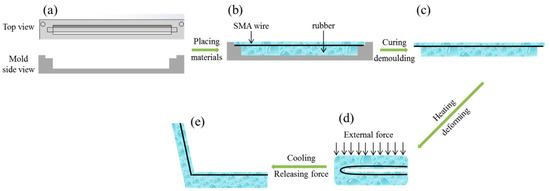
Figure 1.
Fabricating process of rubber-based composite strip: (a) Designing and fabricating of mold. (b) Curing of SMA composite strip. (c) Removing from Teflon mold. (d) Pre-deforming of SMA strip at high temperature. (e) Temporary shape at room temperature.
On the other hand, the rubber was replaced with SMP to improve the load-bearing ability of composite strip at room temperature. The detailed process (Figure 2) mainly included: (1) Heating-treated SMA wire from straight state into “L-shape” at 150 °C for 10 min; (3) Deforming the heated-treated SMA wire into straight state; (3) Placing the straight SMA wire into mold and pouring SMP solution into mold; (4) Curing the SMP-based composite strip for 24 h at 60 °C; (5) Cooling to room temperature and removing mold to obtain the temporary shape of SMP-based strip at room temperature. When the temperature was heated to high temperature, the composite strip would produce bending deformation.

Figure 2.
Fabricating process of SMP-based composite strip: (a) Heat-treated shape of SMA wire. (b) Temporary shape of SMA wire. (c) Teflon mold. (d) Curing of SMP/SMA composite strip. (e) Removing of SMP/SMA strip from mold.
2.2. Tensile Test of SMA Wire at Different Temperatures
The experimental setup for the isothermal test of SMA wire was shown in Figure 3. The initial distance of two grippers was 78.00 mm and the SMA wire was fixed by turning the handle. In this work, we carried out some isothermal tensile experiments from 30 °C to 90 °C at 10 °C intervals to characterize the elastic modulus from martensite to austenite phases based on our previous work of SMA wire in ref [35] with an austenite peak temperature 62 °C. The experimental procedure (taking the tensile test at 30 °C as an example) mainly included five steps: (1) Applying a preload of 10 N under a cross-head speed of 1 mm/min to keep the SMA wire straight. (2) Maintaining the preload, heating to 30 °C at 2 °C/min, and holding for 2 min to arrive at a temperature balance. (3) Loading to 20 N at 1 mm/min. (4) Unloading to 10 N at 1 mm/min and retaining for 2 min. (5) Returning to Step 3 and cycling four times. The experimental procedure under other temperatures was the same as at 30 °C, except for the temperature setting. The Hookean constitutive model was applied to predict the elastic modulus under different temperatures.
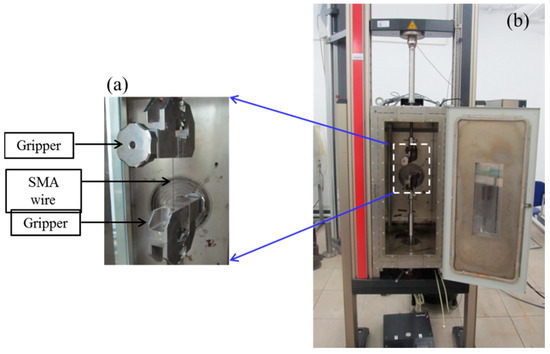
Figure 3.
Experimental setup of the SMA wire tensile test: (a) Gippers and SMA wire. (b) Zwick010 tensile experiment machine.
2.3. Tensile Test of Rubber at Different Temperatures
It is well known that rubber possesses excellent deformation ability [38,39,40]. In this study, the elastic modulus of rubber was characterized by the isothermal tensile experiment from 30 °C to 120 °C at intervals of 10 °C based on the Zwick010 tensile experiment machine (Figure 3). A self-defined, step-by-step procedure was set to avoid the handmade operation error under different temperatures. The procedure mainly included the following steps: (1) Applying a preload of 2 N at 10 mm/min. (2) Maintaining the preload, heating to 30 °C, and holding for 2 min. (3) Deforming to 20 mm at 10 mm/min. (4) Unloading to 2 N at 10 mm/min and retaining for 2 min to finish the tensile experiment at 30 °C. (5) Heating to 40/50/60/70/80/90/100/110/120 °C, and finishing the tensile experiment under different temperature conditions. Similarly, the Hookean model was applied to predict the elastic modulus of rubber under different temperatures.
2.4. Two-Way SME of the Rubber-Based SMA Composite Strip
The two-way reversible bending SME of the rubber-based SMA strip was demonstrated as follows: (1) Putting the SMA strip with prebending deformation into an oven at a temperature of 120 °C to measure the folding process within 5 min. (2) Taking out the SMA strip from the oven and putting it in cool water at 28 °C to show the deploying process within 5 min. The change in the bending angle was recorded to analyze the two-way SME during the heating–cooling cycle.
2.5. Four-Point Bending Test of the SMP-Based SMA Strip
Considering the low elastic modulus of the rubber-based SMA composite strip at room temperature, it was difficult for it to provide enough stiffness for load-bearing. In our previous work [41,42], the thermomechanical properties, including elastic modulus, was characterized based on tensile test. Here, the SMP was used to replace the rubber matrix in order to improve the load-bearing ability. The SMP had a high elastic modulus at room temperature and became rubber-like with low modulus above temperatures of 80 °C. A four-point bending test was conducted to verify the difference in load-bearing ability between rubber- and SMP-based SMA strips at room temperature. The SMA composite strip was seen as a composite beam with a simple support displacement condition, the length was 80 mm between the two ends, and the displacement from the loading position to one end was 20 mm. A laser displacement-measuring device was used to measure the middle position deflection under different weights.
2.6. Two-Way SME of the SMP-Based SMA Composite Strip
The two-way SME of the SMP-based SMA strip was verified by placing it in an oven at a temperature of 120 °C to observe the folding process of the sample within 5 min and then transferring it to low temperature (35 °C) to characterize its deploying process. The change in the bending angle was recorded to analyze the two-way SME during the heating–cooling cycle. It should be noted that the cooling process was carried out at room temperature—not in water—to achieve the deploying process, due to the high variation in stiffness with changing temperature.
3. Results and Discussion
3.1. Static Tensile Results of the SMA Wire under Isothermal Conditions
Figure 4 shows the uniaxial tensile results of the SMA wire from room 25 °C to 90 °C. Figure 4a shows the displacement–load curves of SMA wire in the martensite phase with low stiffness at 25 °C; the displacement was 0.06 mm with the increase in the load from 10 N to 20 N at 1 mm/min. The first loading curve was obviously different from the other three cycles due to some residual strain/stress that was retained after fabrication. The 2nd to 4th loading curves were nearly identical, demonstrating the structural stability of the SMA wire after one cycle. Figure 4b shows the displacement–load curves in the austenite phase at 90 °C with high stiffness, the total displacement was reduced to 0.02 mm under 20 N. It was ~0.35 times the result at 25 °C, and the curves nearly coincided between the 3rd and 4th cycles. Figure 4c shows the displacement–load curves of the SMA wire from 25 °C to 90 °C. The displacements decreased monotonically with increasing temperature, meaning that the stiffness gradually increased with increasing temperature—especially between 50 °C and 70 °C. The load–displacement curves from 25 °C to 30 °C were identical due to the SMA wire being in the martensite phase. Similarly, the SMA wire was in the austenite phase when the temperature was above 80 °C. The elastic moduli under different temperatures can be computed based on Hookean constitutive model. The results showed that the elastic modulus was 18.6 ± 1.0 GPa in the martensite phase and 50.1 ± 1.0 GPa in the austenite phase, as shown in Figure 4d. The significant change in the elastic modulus between 50 °C and 70 °C indicates the austenite phase transformation of the SMA wire. The results were consistent with the DSC measurements in [36].
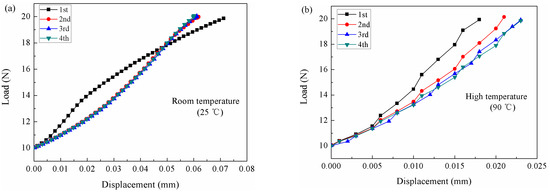
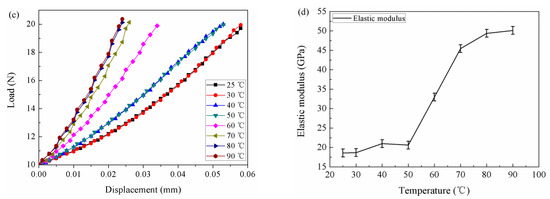
Figure 4.
Static tensile test of SMA wire under different temperatures: (a) Tensile test at 25 °C. (b) Tensile test at 90 °C. (c) Tensile results from 25 °C to 90 °C. (d) Elastic modulus of SMA wire from 25 °C to 90 °C.
3.2. Static Tensile Results of Rubber under Isothermal Conditions
Based on the theory of rubber elasticity, the elastic modulus of rubber is a linear function of temperature under low-strain conditions [43]. Here, we carried out uniaxial tensile tests of rubber with a maximum cross-head displacement of 20 mm from 30 °C to 120 °C. The real displacement gradually decreased with increasing temperature due to some small residual strains that were produced under different temperatures. The initial displacement was 4.059 mm at 30 °C and increased to 10.658 mm at 120 °C. The effective load to arrive at 20 mm displacement decreased with increasing temperature. The load–displacement curves under different temperatures are plotted in Figure 5a, which shows that the stiffness gradually improved with the increase in temperature. The elastic moduli from 30 °C to 120 °C are shown in Figure 5b; the value was 1.248 ± 0.01 MPa at 30 °C and improved to 1.665 ± 0.01 MPa at 120 °C—an increase of 33.41%. A good linear relationship was demonstrated by fitting the experimental results. However, the modulus was still lower than 2 MPa throughout the entire heating process.
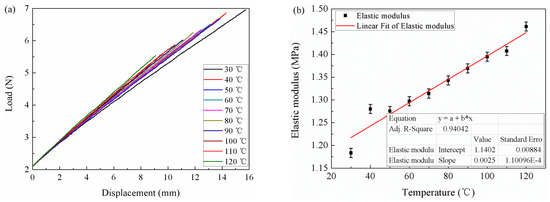
Figure 5.
Static tensile test of rubber under different temperatures: (a) Tensile test from 30 °C to 120 °C. (b) Elastic modulus from 30 °C to 120 °C.
3.3. Two-Way SME of the Rubber-Based SMA Strip
Figure 6 shows the two-way SME of the rubber-based SMA composite strip, with a folding process at 120 °C and a deploying process in cool water at 28 °C. Figure 6a shows that the strip could finish the folding process at 120 °C in 5 min. The total folding process could be divided into three steps: In Step 1 (0–30 s), the shape of SMA strip remained nearly constant due to the low thermal conduction of the rubber. In Step 2 (30–120 s), the SMA strip rapidly bent under the actuation force of the SMA wire caused by the phase transformation. In Step 3 (120–300 s), a new dynamic balance was achieved on the effect of the recovery force of the SMA wire and the elastic force of the rubber to obtain a critical bending angle. Similarly, the deploying process in cool water could also be divided into three steps: In Step 1 (0–15 s), the shape of the SMA strip was nearly unchanged. In Step 2 (15–105 s), the SMA strip rapidly deployed under the elastic force of the rubber and the phase transformation of the SMA wire from austenite to martensite. In Step 3 (105–180 s), a new dynamic balance was achieved, as shown in Figure 6b. It was noted that the deploying time was faster than the folding process, due to the higher thermal conduction of water compared to air. The two-way bending angle during the folding and deploying process is shown in Figure 6c; the shape–recovery ratio could reach 90%.
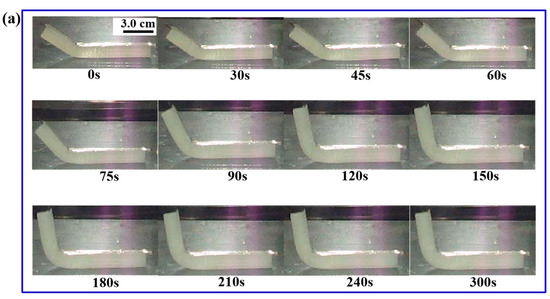
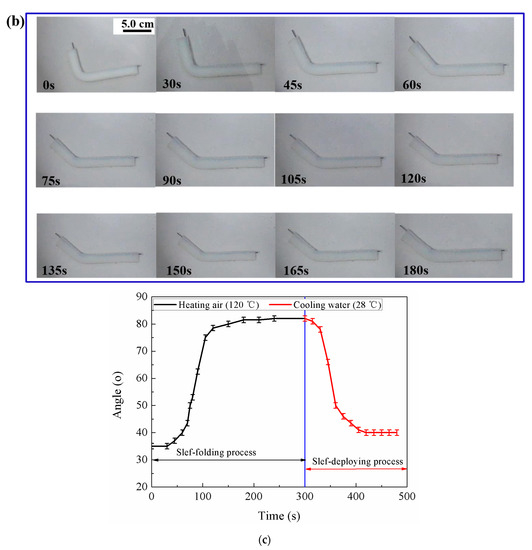
Figure 6.
Two-way SME of the rubber-based SMA strip under the heating/cooling process: (a) Folding process at 120 °C in air. (b) Deploying process at 28 °C in water. (c) Bending angle–time curve under the heating/cooling process.
3.4. Stiffness of the Composite Strip at Room Temperature
The advantage of the high load-bearing ability of the SMP-based SMA composite strip was verified by a four-point bending experiment, as shown in Figure 7a. A laser displacement-measuring device (HL-G103-A-C5, Panasonic Industrial Devices SUNX Corporation, Japan) with accuracy 0.005 mm monitored the center displacement, and a DC Power Supply provided current during the loading process. The weights were suspended one by one to measure the displacements at room temperature 28 °C. The results showed that the rubber-based SMA strip produced a high displacement (8 ± 0.05 mm) at a weight of 400 g. However, the center displacement was only 0.52 ± 0.05 mm for the SMP-based SMA strip when the weight increased to 400 g, and the displacement reached 1.52 ± 0.05 mm at a weight of 700 g, as shown in Figure 7b. The load-bearing ability of the SMP-based SMA strip was 16 times higher than the rubber-based SMA strip at a weight of 400 g.
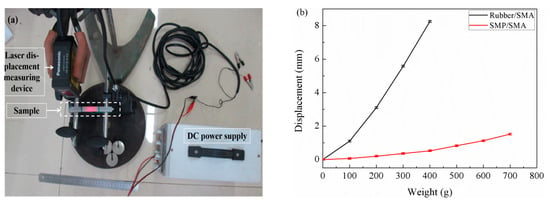
Figure 7.
Displacement–weight measurement of rubber/SMP-based SMA strips at room temperature (28 °C): (a) Experimental setup. (b) Displacement–weight curves.
3.5. Two-Way SME of the SMP-Based SMA Strip
The two-way bending SME with folding at 120 °C and deploying at 35 °C is discussed in this section, as shown in Figure 8. Similar to the rubber-based SMA strip, the SMP-based SMA strip could achieve the folding process within 5 min at 120 °C, as shown in Figure 8a. The total folding process could be divided into three steps: In Step 1 (0–60 s), the shape of the SMA strip was nearly unchanged. In Step 2 (60–180 s), the SMA strip rapidly bent due to the actuation force of the SMA wire and the softening of the SMP. In Step 3 (180–300 s), a new dynamic balance was achieved in the effect of the recovery force of the SMA wire and SMP on the rubber state to obtain a critical bending angle. Unlike the rubber-based SMA strip, the deploying process was slower than in cool water due to the low thermal conduction of air. In addition, some large residual deformation was retained after 10 min due to the high elastic modulus of the SMP at glass state, which hindered the recovery of the SMP, as shown in Figure 8b. The two-way reversible bending angle under the heating–cooling cycle was as shown in Figure 8c, and the total shape-recovery ratio of the SMP-based SMA was ~80%. Although the shape–recovery ratio slightly declined compared with the 90% for the rubber-based SMA strip, the load-bearing ability was obviously improved by more than 16-fold.


Figure 8.
Two-way SME of the SMP-based SMA strip under the heating/cooling process: (a) Folding process at 120 °C in air. (b) Deploying process at 35 °C in air. (c) Bending angle curve under the heating/cooling process.
3.6. Cyclic Deformation of Rubber and SMP-Based SMA Strips
The reversible bending angles of rubber and SMP-based SMA strips were investigated by the heating–cooling cycle process between 120 °C and 20 °C for 20 times, as shown in Figure 9. The results showed the angles of composite strips have not obviously decayed at high/low temperatures, respectively. The critical bending angle of the rubber-based SMA strip at 120 °C declined from 79° to 77° during the firstly 10 cycles and retained the angle until 20 cycles. The critical value of the SMP-based SMA strip at 120 °C declined from 71° to 70° during the firstly 10 cycles and retained the angle until 20 cycles. The critical value of rubber-based strip was higher than SMP-based strip due to the higher elastic modulus of SMP compared to rubber at high temperature. In addition, the critical value of rubber-based strip kept 30°, and the value of SMP-based strip kept 32° at room temperature 20 °C for the first 20 heating–cooling cycles.

Figure 9.
Two-way reversible bending angles for the first 20 cycles.
4. Future Applications
A flower-like, space-deployable antenna model with a folding–deploying ratio 0.85 (195 mm for folding and 230 mm for deploying state) was demonstrated in ref [35]. Here, we proposed an improved method shown in Figure 10 to reduce the folding diameter of antenna model based on the following fabrication steps: (1) Preparing four SMA composite strips, pair of cylinder base structures (inner 6 mm and outer diameter 55 mm), a screw, and nut; (2) Assembling these components into the skeleton of the antenna model; (3) Gluing a ring-shaped polyimide (PI) film (inner 80 mm and outer diameter 200 mm) with a curved SMA thin film (length 70 mm × width 2 mm × thickness 0.3 mm) between two adjacent SMA composite strips on the top surface of SMA composite strips by silicon adhesive to form the space-deployable antenna model.

Figure 10.
Fabricating process of space deployable antenna model: (a) Fabricating of antenna components. (b) Skeleton of antenna model. (c) Antenna model with PI film.
The results showed that the folding–deploying ratio of the antenna diameter could be reduced to 0.72 (165 mm for folding and 230 mm for deploying state) within 10 min at an oven temperature of 120 °C, as shown in Figure 11. The main reason was the aided actuation effect of the SMA thin film to predetermine the bending direction of the PI thin film under the heating process.
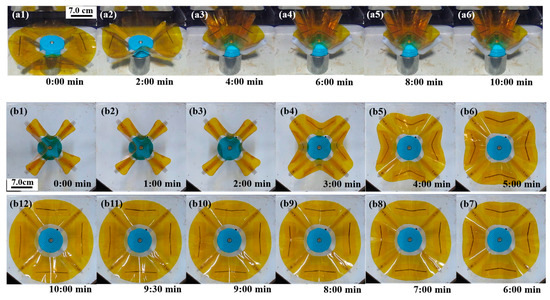
Figure 11.
Two-way SME of an antenna model of rubber-based SMA composite strips with a curved SMA thin film: (a1–a6) Self-folding process at 120 °C. (b1–b12) self-deploying process at room temperature.
As mentioned above, the low stiffness of the rubber-based SMA composite strips at low temperature meant that they could not provide high load-bearing ability. An antenna model based on SMP-based SMA composite strips was developed to improve the load-bearing ability and verify the two-way reversible bending SME at 120 °C and 35 °C, as shown in Figure 12.

Figure 12.
Two-way SME of an antenna model of SMP-based SMA composite strips with a curved SMA thin film: (a1–a6) Self-folding process of SMP-based antenna model at 120 °C. (b1–b12) self-deploying process at 35 °C.
The folding process of the SMP-based antenna model shown in Figure 12 was similar to that shown in Figure 11, and the folding–deploying ratio of the antenna diameter was 0.74 (161 mm for folding and 217 mm for deploying state) due to the SME the SMA wire. However, the deploying process of the SMP-based antenna model was obviously different from that of the rubber-based model due to the restrictive effect of the increasing stiffness of the SMP matrix at glass state. In addition, the creep properties of SMP, as shown in ref [44,45], could delay the deploying process, and the total deploying process took 80 min at 35 °C to achieve a diameter of 216 mm. The recovery time was eight times that of the rubber-based model during the deployment process.
5. Conclusions
In this work, a kind of rubber-based and SMP-based SMA composite strip was fabricated, and the thermomechanical properties of SMA wire were characterized with increasing elastic modulus from 18.6 GPa (martensite phase) to 50.1 GPa (austenite phase) during the heating process. The good two-way bending behaviors of composite strips were demonstrated under the heating/cooling process, and the shape recovery ratio was higher than 80% during the deploying process at room temperature. The load-bearing ability of the SMP-based SMA strip at 28 °C was 16 times higher than that of the rubber-based SMA strip at a weight of 400 g. Finally, the rubber/SMP-based composite strips in a space-deployable antenna model with two-way, self-folding/-deploying SME were developed to demonstrate the feasibility for future space deployable structure applications. Although the SMP-based antenna model owned high stiffness for load-bearing ability, the self-deploying time was eight times that of the rubber-based model during the deployment process.
Author Contributions
Conceptualization, H.D.; methodology, H.D.; investigation, H.D.; writing—original draft preparation, Y.Y. and Y.L.; writing—review and editing, W.Z. All authors have read and agreed to the published version of the manuscript.
Funding
The research is supported by the Science Foundation of National Key Laboratory of Science and Technology on Advanced Composite in Special Environments and the Natural Science Foundation of Hebei Province (A2020402018).
Institutional Review Board Statement
Not applicable.
Informed Consent Statement
Not applicable.
Data Availability Statement
The data presented in this study are available on request from the corresponding author.
Conflicts of Interest
The authors declare no conflict of interest.
References
- Song, G.B.; Ma, N.; Li, H.N. Applications of shape memory alloys in civil structures. Eng. Struct. 2006, 28, 1266–1274. [Google Scholar] [CrossRef]
- Morgan, N.B. Medical shape memory alloy applications-the market and its products. Mater. Sci. Eng. A 2004, 378, 16–23. [Google Scholar] [CrossRef]
- Hartl, D.J.; Lagoudas, D.C. Aerospace applications of shape memory alloys. Proc. Inst. Mech. Eng. 2007, 221, 535–552. [Google Scholar] [CrossRef]
- Choyal, V.; Khan, S.; Mani, P.S.S.; Palani, I.A.; Singh, P. Active and passive multicycle actuation characteristics of shape memory alloy-based adaptive composite structures. Smart Mater. Struct. 2021, 30, 095022. [Google Scholar] [CrossRef]
- Shelyakov, A.V.; Sitnikov, N.N.; Koledov, V.V.; Kuchin, D.S.; Irzhak, A.V.; Tabachkova, N.Y. Melt-spun thin ribbons of shape memory TiNiCu alloy for micromechanical applications. Int. J. Smart Nano Mater. 2011, 2, 68–77. [Google Scholar] [CrossRef]
- Yang, Y.; Wang, Y.Q.; Yao, T.; Feng, X.J. A flexible carbon fibre-based electrothermal film for fast actuation of shape memory alloy sheets. Smart Mater. Struct. 2022, 31, 045019. [Google Scholar] [CrossRef]
- Akbari, S.; Sakhaei, A.H.; Panjwani, S.; Kowsari, K.; Ge, Q. Shape memory alloy based based 3D printed composite actuators with variable stiffness and large reversible deformation. Sens. Actuators A Phys. 2021, 321, 112598. [Google Scholar] [CrossRef]
- Xie, T. Tunable polymer multi-shape memory effect. Nature 2010, 464, 267–270. [Google Scholar] [CrossRef] [PubMed]
- Liu, Y.J.; Du, H.Y.; Liu, L.W.; Leng, J.S. Shape memory polymers and their composites in aerospace applications: A review. Smart Mater. Struct. 2014, 23, 023001. [Google Scholar] [CrossRef]
- Meng, Q.H.; Hu, J.L. A review of shape memory polymer composites and blends. Compos. Part A 2009, 40, 1661–1672. [Google Scholar] [CrossRef]
- Lee, H.T.; Seichepine, F.; Yang, G.Z. Microtentacle actuators based on shape memory alloy smart soft composite. Adv. Funct. Mater. 2020, 30, 2002510. [Google Scholar] [CrossRef]
- Ashir, M.; Nocke, A.; Cherif, C. Development of shape memory alloy hybrid yarns for adaptive fiber reinforced plastics. Text. Res. J. 2019, 89, 1371–1380. [Google Scholar] [CrossRef]
- Ashir, M.; Hahn, L.; Kluge, A.; Nocke, A.; Cherif, C. Development of innovative adaptive 3D fiber reinforced plastics based on shape memory alloys. Compos. Sci. Technol. 2016, 126, 43–51. [Google Scholar] [CrossRef]
- Ashir, M.; Hahn, L.; Kluge, A.; Nocke, A.; Cherif, C. Electro-bending characterization of adaptive 3D fiber reinforced plastics based on shape memory alloys. Smart Mater. Struct. 2016, 25, 035041. [Google Scholar] [CrossRef]
- Ashir, M.; Nocke, A.; Theiss, C.; Cherif, C. Development of adaptive hinged fiber reinforced plastics based on shape memory alloys. Compos. Struct. 2017, 170, 243–249. [Google Scholar] [CrossRef]
- Ashir, M.; Nocke, A.; Hanke, U.; Cherif, C. Adaptive hinged fiber reinforced plastics with tailored shape memory alloy hybrid yarn. Polym. Compos. 2020, 41, 191–200. [Google Scholar] [CrossRef]
- Wang, W.; Rodrigue, H.; Kim, H.I.; Han, M.W.; Ahn, S.H. Soft composite hinge actuator and application to compliant robotic gripper. Compos. Part B 2016, 98, 397–405. [Google Scholar] [CrossRef]
- Wang, W.; Tang, Y.X.; Li, C. Controlling bending deformation of a shape memory alloy-based soft planar gripper to grip deformable objects. Int. J. Mech. Sci. 2021, 193, 106181. [Google Scholar] [CrossRef]
- Wang, W.; Rodrigue, H.; Ahn, S.H. Soft composite actuator with shape retention capability using embedded fusible alloy structures. Compos. Part B 2015, 78, 507–514. [Google Scholar] [CrossRef]
- Wang, W.; Rodrigue, H.; Ahn, S.H. Deployable soft composite structures. Sci. Rep. 2016, 6, 20869. [Google Scholar] [CrossRef] [PubMed]
- Wang, W.; Kim, N.G.; Rodrigue, H.; Ahn, S.H. Modular assembly of soft deployable structures and robots. Mater. Horiz. 2017, 4, 367–376. [Google Scholar] [CrossRef]
- Cortes, P.; Cantwell, W.J.; Kuang, K.S.C.; Quek, S.T. The morphing properties of a smart fiber metal laminate. Polym. Compos. 2008, 29, 1263–1268. [Google Scholar] [CrossRef]
- Feng, N.; Liu, L.W.; Liu, Y.J.; Leng, J.S. Characteristics of multi-functional composites using elastomer embedded with shape memory alloy wire. Mater. Des. 2015, 88, 75–81. [Google Scholar] [CrossRef]
- Pieczyska, E.; Kowalczyk-Gajewska, K.; Maj, M.; Staszczak, M.; Tobushi, H. Thermomechanical Investigation of TiNi Shape Memory Alloy and PU Shape Memory Polymer Subjected to Cyclic Loading. Procedia Eng. 2014, 74, 287–292. [Google Scholar] [CrossRef]
- Tobushi, H.; Hayashi, S.; Hoshio, K.; Makino, Y.; Miwa, N. Bending actuation characteristics of shape memory composite with SMA and SMP. J. Intell. Mater. Syst. Struct. 2006, 17, 1075–1081. [Google Scholar] [CrossRef]
- Tobushi, H.; Pieczyska, E.; Ejiri, Y.; Sakuragi, T. Thermomechanical properties of shape memory alloy and polymer and their composites. Mech. Adv. Mater. Struct. 2009, 16, 236–247. [Google Scholar] [CrossRef]
- Tobushi, H.; Hayashi, S.; Sugimoto, Y.; Date, K. Two-way bending properties of shape memory composite with SMA and SMP. Materials 2009, 2, 1180–1192. [Google Scholar] [CrossRef]
- Lelieveld, C.M.J.L.; Jansen, K.M.B. Thermal-electric characterization and modelling of a smart composite structure for architectural applications. Smart Mater. Struct. 2014, 23, 065010. [Google Scholar] [CrossRef]
- Lelieveld, C.M.J.L.; Jansen, K.M.B.; Teuffel, P. Mechanical characterization of a shape morphing smart composite with embedded shape memory alloys in a shape memory polymer matrix. J. Intell. Mater. Syst. Struct. 2016, 27, 2038–2048. [Google Scholar] [CrossRef]
- Ghosh, P.; Rao, A.; Srinivasa, A.R. Design of multi-state and smart-bias components using shape memory alloy and shape memory polymer composites. Mater. Des. 2013, 44, 164–171. [Google Scholar] [CrossRef]
- Taya, M.; Liang, Y.C.; Namli, O.C.; Tamagawa, H.; Howie, T. Design of two-way reversible bending actuator based on shape memory alloy/shape memory polymer composite. Smart Mater. Struct. 2013, 22, 105003. [Google Scholar] [CrossRef]
- Kang, M.; Pyo, Y.; Jiang, J.Y.; Park, Y.; Son, Y.H.; Choi, M.C.; Ha, J.W.; Chang, Y.W.; Lee, C.S. Design of a shape memory composite (SMC) using 4D printing technology. Sens. Actuators A Phys. 2018, 283, 187–195. [Google Scholar] [CrossRef]
- Wang, W.; Ahn, S.H. Shape memory alloy-based soft gripper with variable stiffness for compliant and effective grasping. Soft Robot. 2017, 4, 379–389. [Google Scholar] [CrossRef] [PubMed]
- Wang, W.; Yu, C.Y.; Serrano, A.A.; Ahn, S.H. Shape memory alloy-based soft finger with changeable bending length using targeted variable stiffness. Soft Robot. 2020, 7, 283–291. [Google Scholar] [CrossRef] [PubMed]
- Du, H.Y.; Yao, Y.T.; Zhao, Y.J. A space deployable antenna model based on shape memory alloy composite with folding-deploying two-way behavior. Polym. Adv. Technol. 2022, 33, 4214–4222. [Google Scholar] [CrossRef]
- Du, H.Y.; Yao, Y.T.; Zhou, X.L. A facile fabricating method for smart soft robotic hand. Polym. Eng. Sci. 2023, 63, 118–125. [Google Scholar] [CrossRef]
- Zhang, D.W.; Lan, X.; Liu, Y.J.; Leng, J.S. Influence of cross-linking degree on shape memory effect of styrene-based copolymer. Proc. SPIE 2007, 6526, 670–675. [Google Scholar]
- Boyce, M.C.; Arruda, E.M. Constitutive models of rubber elasticity: A review. Rubber Chem. Technol. 2000, 73, 504–523. [Google Scholar] [CrossRef]
- Bechir, H.; Chevalier, L.; Idjeri, M. A three-dimensional network model for rubber elasticity: The effect of local entanglements constraints. Int. J. Eng. Sci. 2010, 48, 265–274. [Google Scholar] [CrossRef]
- Destrade, M.; Dorfmann, L.; Saccomandi, G. The Ogden model of rubber mechanics: 50 years of impact on nonlinear elasticity. Philos. Trans. R. Soc. A 2022, 380, 20210332. [Google Scholar] [CrossRef]
- Du, H.Y.; Liu, L.W.; Zhang, F.H.; Zhao, W.; Leng, J.S.; Liu, Y.J. Thermal-mechanical behavior of styrene-based shape memory polymer tube. Polym. Test. 2017, 57, 119–125. [Google Scholar] [CrossRef]
- Du, H.Y.; Liu, L.W.; Zhang, F.H.; Leng, J.S.; Liu, Y.J. Triple-shape memory effect in a styrene-based shape memory polymer: Characterization, theory and application. Compos. Part B Eng. 2019, 173, 106905. [Google Scholar] [CrossRef]
- Liu, Y.P.; Gall, K.; Dunn, M.L.; Greeberg, A.R.; Diani, J. Thermomechanics of shape memory polymers: Uniaxial experiments and constitutive modeling. Int. J. Plast. 2006, 22, 279–313. [Google Scholar] [CrossRef]
- Guo, X.G.; Liu, L.W.; Liu, Y.J.; Zhou, B.; Leng, J.S. Constitutive model for a stress- and thermal-induced phase transition in a shape memory polymer. Smart Mater. Struct. 2014, 23, 105019. [Google Scholar] [CrossRef]
- Guo, X.G.; Liu, L.W.; Zhou, B.; Liu, Y.J.; Leng, J.S. Constitutive model for shape memory polymer based on the viscoelasticity and phase transition theories. J. Intell. Mater. Syst. Struct. 2016, 27, 314–323. [Google Scholar] [CrossRef]
Disclaimer/Publisher’s Note: The statements, opinions and data contained in all publications are solely those of the individual author(s) and contributor(s) and not of MDPI and/or the editor(s). MDPI and/or the editor(s) disclaim responsibility for any injury to people or property resulting from any ideas, methods, instructions or products referred to in the content. |
© 2023 by the authors. Licensee MDPI, Basel, Switzerland. This article is an open access article distributed under the terms and conditions of the Creative Commons Attribution (CC BY) license (https://creativecommons.org/licenses/by/4.0/).